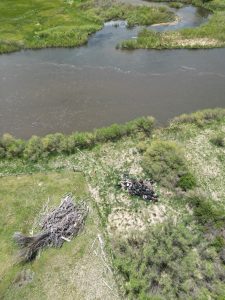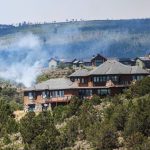Decades in the making: Vail Valley’s workforce housing crisis has been building since the beginning

Special to the Daily
- Wednesday: Housing done right: How some employers are meeting Vail Valley’s housing challenges
- Wednesday: Good deeds: Vail InDEED program catching attention elsewhere
Editor’s note: This story is the second in a five-day series focused on housing issues in the Vail Valley. To view the entire series as it unfolds, visit vaildaily.com/news/home-economics.
The front page of the first issue of the short-lived Daily Trail newspaper said it all back in late June 1998: “Gore Creek ghost town: The changing face of Vail.” The story launched a five-part series on the affordable housing crisis and chronicled the runaway real estate industry and the hollowing out of Vail’s year-round community with 70% second homeownership.
The ensuing two decades have seen very little progress in terms of slowing the downvalley exodus of year-round residents in search of cheaper land and lower home prices. In fact, things have only gotten worse, with Vail’s rate of second homeownership now at 80% — and an identical 80% of employers saying lack of housing is hurting their ability to hire workers.
On that very same front page was a photo of three generations of Seiberts, including Vail founder Peter Seibert, his son Pete Jr. and grandson Petey. Pete Jr., a Realtor, recently moved back to Vail and lives in a town-subsidized affordable housing complex known as Chamonix Vail. In November, he narrowly missed being elected to Vail Town Council running on a platform supportive of the town’s innovative Vail InDEED voluntary deed-restriction program.
And in the upper right corner of that first issue of the Daily Trail was a photo of one of Vail’s founding mothers, Diana Donovan, teasing a story about her opposition to an affordable housing plan on town-owned land known as Common Ground and spearheaded by then-Mayor Rob Ford. That opposition, in part, led to the failure of that ambitious housing plan and Ford’s resignation two years into his four-year term — a move that made national headlines.

Support Local Journalism

Special to the Daily
Under the headline “Housing for Poorer Neighbors Offends Vail’s Rich,” The New York Times quoted Ford saying, “”At some of the meetings we had, things got so bad that I was uncomfortable without an undercover police officer there to protect me. At times I thought guys were going to pop me right there in Town Hall.”
Things at times seemed equally heated during the debate over the recently approved workforce housing project in East Vail known as Booth Heights, but ironically, Ford and Donovan were on the same side in opposition to that project. The rancor just underscores how bitterly divisive the new construction of high-density, multi-unit, urban-style housing projects can be in a place that markets itself as a rural mountain retreat with massive, spacious homes and unobstructed views.
Vail Valley Partnership President and CEO Chris Romer says businesses that belong to the valleywide chamber consistently rank housing as their top hurdle for growing their companies and retaining employees — a critical challenge in a service-sector resort economy — and yet he’s had his fair share of that feeling Ford had in 1999 because of his support for Booth Heights and other workforce projects. He recently started a Facebook video series called VVP Mean Emails from NIMBY’s (Not in My Back Yard).
There was some hue and cry when the town of Vail first proposed using public funds to buy 1,000 more deed restrictions on Vail housing units by 2027 to keep a total of 1,700 deed-restricted units in the pool for local, year-round residents. Now that program is being hailed as a national model, and town officials may ask voters for a permanent funding source for the program next November.
In surveys the town has done on the topic, Vail Housing Director George Ruther says employers consistently said they’re not getting their top three choices when it comes to hiring — primarily because of the high cost of housing — but instead are settling on their sixth, seventh and eighth choices.
“I do believe about the only thing we buy, sell and trade in here in the valley is customer service,” Ruther said ahead of a housing conference in Vail earlier this year. “Just about everything that we do is some form of customer service, and when you’re relying upon the very best of the best customer service coming from maybe not the best employment pool, there’s going to be consequences down the road.”
Ruther thinks Vail, where an estimated 90% of real estate sales go to out-of-town second-home owners, will pay a long-term economic price for failing to mitigate the problem.

“I also share in talking with folks, if you can’t get your head around the stories of people living in cars or living … six people to a two-bedroom house, just think about the economic impacts of not addressing this issue — when it comes to recruitment or retention or training or quality of service,” Ruther said.
How did we get here?
Former Vail Mayor Ludwig Kurz originally hails from Salzburg, Austria, and says the resorts in his home country and the birthplace of Alpine skiing typically do not have a high percentage of absentee homeownership. They are mostly made up of hotels, lodges and resort businesses. Vail began in the late ’50s and early ’60s by selling shares that included a piece of land and a ski pass.
That real-estate first culture meant that a narrow valley with limited private land wedged between huge swaths of publicly owned national forests would have a hard time housing workers— especially as Vail exploded into the very definition of a modern, destination, mega-resort.
“That really goes way back, and not just into Vail’s culture but pretty much any one of these [ski resort communities], golf communities or whatever it might be, where the leg of the stool was real estate, and then construction that comes along with it, and not the idea that you’re trying to create a community for people to live in,” said Stan Zemler, the longest-tenured town manager in Vail history who stepped down in 2017 after 13 years. “So, in a lot of ways, that ship sailed a long ways back when you just basically started building buildings to sell the units.”
Zemler landed in Vail in 2003 at the beginning of a massive $2 billion redevelopment spree, but prior to that he spent six years as president and CEO of the Boulder Chamber of Commerce and six years as Boulder’s deputy city manager. The construction crane became the unofficial town bird of Vail for the next five years, with new and redeveloped high-end hotel projects taking off from the The Arrabelle at Vail Square to Solaris Residences to the Four Seasons to the Ritz-Carlton Residences.
But workforce housing projects or deed-restriction programs weren’t at the top of the list for an aging resort looking to keep up with the Deer Valleys of the world, and then the Great Recession of 2008 hit and the town opted for streetscape projects, new firehouses and overall fiscal conservatism versus risking public funds on housing at a time when home values were plummeting. Zemler was just glad all the big projects got completed on schedule.
He’s a touch philosophical when asked if Vail missed an opportunity on workforce housing.
“We did buy some stuff. Did we buy enough? No. Could we possibly buy enough? No. Did we probably miss a window?” Zemler asked rhetorically. “I look back on my time in Boulder and … in the ’80s recession we should have bought 25 apartment buildings. So the same kind of thing applies. Could we have done more (in Vail in 2008)? Sure.”
Where do we go from here?
East West Partners founder Harry Frampton — the developer behind the success of Beaver Creek in the 1980s and the rebirth of downtown Denver with Riverfront Park and Union Station — told the Colorado Sun in May that the Village at Avon land owned by Magnus Lindholm should be purchased well above market value by the many government jurisdictions in the Vail Valley and they should then build 1,000 or more units of affordable housing there.
Frampton is partners with former Vail Mayor Rod Slifer in one of the most successful high-end real estate companies in Colorado — Slifer Smith & Frampton Real Estate— and thinks there’s a dire need for all types of housing in Eagle County, from seasonal workforce to attainable middle-income units for young families. He also thinks it should be built throughout the valley.
“Any land we’ve got left. I don’t care. Put some in Vail, some in Avon, some in Edwards and not just move everybody to, we’ll call it to west Gypsum, right?” Frampton said, acknowledging the need for better public transportation throughout the entire county. “Everything we do should be to discourage cars and encourage pedestrian walking and public transportation. Every decision. I understand we’re spread out, different areas, you’ve got to move back and forth. But how do we discourage traffic and cars?”
And Frampton takes issues with the basic tenets of NIMBYism — the feeling that people in workforce housing are somehow bad for the neighborhood.
“I think, as a general rule, we people who’ve kind of made it, we kind of figure workforce housing is the bad people. BS. We all started in workforce housing, did we not?” Frampton said. “At some point in time, we all did. We’re talking about people who are good people. They’re our future leaders.”
Diana Donovan’s daughter, Kerry, a Democratic state senator from Vail, puts the housing debate into an environmental context, with greater sprawl leading to increased vehicle traffic.
“You start tagging it to a climate change debate, because if we put people in Dotsero, you then ask them to drive a single-passenger car upvalley five to six days a week,” Donovan said. “So you either build housing where people work or you start developing a very efficient and frequent mass transportation system. It’s one or the other, and I think ultimately it will be a combination of both.”
That being said, Donovan says people need to be realistic and realize that even a two-income family will not be able to afford a four-bedroom home with a garage and a yard in Vail.
“That’s just never going to happen,” she said. “I saw this with my friends; they chose between living in Vail or basically having a garage.”
Regulatory approaches
One of the biggest curveballs of the last 10 years has been the short-term rental trend that in Vail further reduces the pool of 20% year-round housing by taking potential long-term rentals out of the mix for local workers. Donovan says she’s considering some type of statewide legislation aimed at short-term rental companies like VRBO and Airbnb and the homeowners who use them to turn their condos into ski-lodge cash machines.
“I don’t think there was any early recognition that (short-term rentals) could have an effect on workforce housing,” Zemler said. “It took a long time to kind of get your arms around the fact that this might not be great for communities that have limited housing stock.”
Eagle County Manager Jeff Shroll says the county has been taking stock of the number of short-term rentals cropping up in unincorporated areas of the Vail Valley and having serious conversations about how best to deal with the trend from a regulatory standpoint. Besides growing parking and noise complaint issues in some neighborhoods, there are bigger concerns.
“Our biggest concern is losing workforce housing, because every time you fill one of those places up (short term) that’s somebody else that can’t live there now — that could be and should be living and working upvalley that could rent it out at least even seasonally,” Shroll said. “That’s now off the market because (owners) can make more money renting it out weekend by weekend.”
Like Vail InDEED, there’s been some talk of the county trying to go after a more permanent funding source for coping with the housing shortage, although officials may be a bit leery after the resounding defeat of a proposed housing tax in 2016. And some say it makes more sense to seek a transportation tax to better build out ECO Transit to move workers around the valley, but those questions wouldn’t hit a ballot until 2020 at the earliest — if at all.

Special to the Daily
Meanwhile, the Eagle County Planning Commission is reviewing changes to the county’s housing guidelines at a work session on Wednesday — changes primarily focused on private developers. One longtime planner sounded a cautionary note about past mistakes.
“The problem so far with the idea of an update to the guidelines is really not having a good grasp of their success or failure,” Dominic Mauriello of the Mauriello Planning Group said. “For the most part, the guidelines, as well-intentioned as they are to produce workforce housing units, have largely failed over the last 20 years or so.”
Mauriello would like to see greater collaboration between government and private sector.
“There is a huge disconnect between what the government thinks works and what actually will work for developers,” Mauriello added. “There should, therefore, be a public-private group that works on the guidelines to get the best potential result, putting everything on the table for discussion.”











